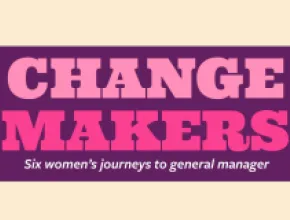With a still-sluggish economy casting its shadow over the meetings landscape, staying within a limited budget can be the first priority for any planner, but it’s easy to fall into the trap of saving a few dollars at the “expense” of leaving attendees underwhelmed.
“Budget restrictions have always been part of the meetings landscape,” says Ann Godi, CMP, president and CEO of Benchmarc360°, a meeting management solutions provider in Atlanta. “No time in our history has been more significant than 2009-2011, but now budgets are inching up and we are finally seeing more spend in areas that were hardest hit–speakers, decor and entertainment.”
Even if you’re not witnessing a budget boost there is still hope to craft a truly memorable experience—as witnessed by several professionals who offer their advice on food and beverage, decor, team building, audiovisual presentation and entertainment.
Fiscal but Fun F&B
During the course of the last 15 years, Kristi Martin worked as an event planner at two bed and breakfasts and was catering manager at the Westin Charlotte Hotel in North Carolina. In February of 2012, she started up Feast Food Tours & Culinary Events, which plans themed food and team-building activities for smaller groups in Charlotte, N.C.
“Right now I host four different walking tours of Charlotte that are choreographed in such a way that we stop at about six different locations, meet the chefs, maybe get behind the scenes, get cooking demonstrations or education, and of course eat and drink along the way as well,” Martin says.
Food tours are springing up in a number of major (and smaller) meetings destinations, and while the per-person cost may be higher than just planning a regular meal, these events often combine eating and team building, which provides two activities in one and saves money along the way.
Using local food trucks at an event is another option that can spice up the dining for attendees, but Martin recommends planners make sure to look into venue rules to verify they allow using outside vendors in combination with (or in lieu of) the on-site provider.
Outside of food tours, Martin says planners should keep an open dialogue with catering managers and chefs and make them fully aware of the available budget, as they are generally more than willing to make accommodations for those who take the time to ask.
“I think a lot of chefs in hotels or restaurants get bored of doing the same thing over and over again, so the minute they’ve got someone willing to think outside of the box, even if it’s on a budget, they’re more likely to be excited about it and do nice things,” she says.PageBreak
Dollar-Saving Decor
Another aspect of planning that often accompanies food and beverage services is decor, which varies based on your audience and demographics, as some groups may care more about flowers and other costly items, while other groups won’t even notice these things.
“When I worked at Boeing, my audience was mostly men. I did a meeting for 1,000 executives and they didn’t notice the decor,” says Arlene Sheff, CMP, former senior meeting and event planner for The Boeing Company and currently a meetings consultant. “So instead of spending money on floral centerpieces, I asked the hotel to put together a fancy bread basket, with a variety of rolls and nut breads, lavosh and bread sticks for each table, like they had in the restaurant.”
Some attendees will be more satisfied with a functional centerpiece that can be incorporated into the meal, such as the dessert, bread or fruit-based option as mentioned by Sheff. She also recommends using distinctly colored napkins and other seemingly simple minor additions that will help create a theme for the meal.
“I’d often order napkins for the center of every table, so if they had a white tablecloth, I’d order a colored napkin to add some festivity,” she says. “Flowers are expensive, so you have to decide whether decor is important to the group.”
Bonding on a Budget
Corporate social responsibility (CSR) is creating a buzz in the meetings industry, and sometimes these same events that give back to the community can also be the most cost-effective for groups.
John Logan, owner and operator of Adventure Alliance, a team-building company based in Georgetown, Texas, says he has noticed a recent spike in groups looking to take part in CSR events.
“This is becoming more and more popular for options like the Wounded Warrior Project, Habitat for Humanity or supporting a school in a low-income district,” he says.
While technology-based team building has also been on the rise (Logan says there are a few good scavenger apps out there planners can utilize.), sometimes the more traditional methods are still the most cost-effective.
“Meeting planners need to be honest about their budget and have reasonable expectations based on what’s available,” Logan says. “That being said, don’t just presume because of prior history that a team builder is going to be out of your budget, as we can usually surprise clients with what we can do.”
Adventure Alliance frequently relies on using on-site or near-site workshops to cut costs for groups who may not be able to travel far from the workplace for meetings. The group’s most popular activities are its portable initiatives workshops, which are ground-based problem-solving activities that can be done outdoors or inside, such as the group’s Minute to Win It-style game that has teams competing against the clock to complete challenges using inexpensive resources.
Some other affordable suggestions offered by Logan include model rocket building, chili cook-offs, scavenger hunts, raft building and gift bags/letters for veterans, or care packages for the homeless. PageBreak
Affordable AV
Finding the right speakers and content is necessary to provide educational value in a meeting, but audiences can quickly lose interest if the presentation is full of glaring AV mishaps.
“People turn on their TVs and their computers, or they go to a concert, and they get all this razzmatazz and they want it at their conference because they’re used to it, but that costs money,” says Sandy Biback, CMP, CMM, owner of Imagination Meetings in Toronto. “I think one way today of really giving attendees a lot of that without spending a lot is the use of lighting. The LED they’ve got out there today is amazing and it’s so cost-effective.”
Biback believes LED lighting has changed the way people are planning meetings and says it adds an aesthetic appeal which was previously unavailable to those working on a restricted budget.
“When people come into the room, you can set the mood with whatever coloring you want, and different colors evoke different emotions,” she says. “You can even add in some music to create the desired atmosphere.”
AV is typically something best left into the hands of professionals and, as Biback points out, some hotels and convention centers have taken notice and started installing lighting and audio equipment of their own at higher costs. She recommends looking into using an outside AV company, if it’s allowed at the venue, to reduce expenses and make contract negotiation easier.
Penny-Smart Performers
While having good audiovisual presentation has become essential to any meeting, people also are looking to be entertained, which can be difficult to accomplish without a lot of money. A great cost-saving method of finding both speakers and entertainers is taking advantage of the local talent in the area.
“You have to know your client and who’s coming to your event,” Biback says. “At one event we wanted something upbeat, so we went to a local school that has a very large Caribbean population here in Toronto, and they had this great calypso band. The kids loved to come and perform and we provided them with some food and paid for any travel expenses, and they just enjoyed having the opportunity to perform and have fun.”
She also recommends planners make sure they are looking within their own industry for speakers who may be willing to work for reduced rates, but at the end of the day you have to treat speakers with respect and at a minimum cover travel costs and other expenses.
“One of the things we do with our clients is create a ‘Leave a Legacy’ program, so wherever we are we find a charity that aligns itself with the group,” Biback says. “For some speakers, instead of paying them, we paid their expenses and made a donation on their behalf to the charity we chose.”
A tax write-off and a way to give back as well. Now that’s creative cost-cutting at its best.







